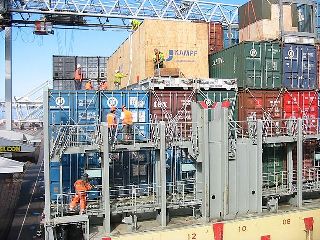 Confidence levels in the shipping industry fell during the three months to November 2014 to their lowest level for two years over concerns about the high cost of complying with new regulations as well as the continued overtonnage and over-ordering, according to a recent survey.
Confidence levels in the shipping industry fell during the three months to November 2014 to their lowest level for two years over concerns about the high cost of complying with new regulations as well as the continued overtonnage and over-ordering, according to a recent survey.
But the latest Shipping Confidence Survey of Moore Stephens also showed that charterers, managers, and brokers were more confident than they were three months previously of making a new investment over the coming year.
In November 2014, the average confidence level expressed by respondents in the markets in which they operate was 5.7 on a scale of 1 (low) to 10 (high), down from the 6.1 recorded in August 2014. This compares to the record high of 6.8 when the survey was launched in May 2008.
All categories of respondent recorded a fall in confidence this time, most notably charterers and owners. Geographically, confidence was down in Asia and Europe, while confidence in North America held steady.
The cost of meeting the growing regulatory burden in the shipping industry was high on the list of concerns expressed by respondents, as they noted its impact on operational expenses and investment plans.
Another worrying issue raised was the situation of overtonnaging which respondents said would “continue to slow the rate of recovery” and “add to the lingering fear of a collapse in freight rates.”
Demand trends, competition, and finance costs, in that order, once again featured as the top three factors cited by respondents overall as those likely to influence performance most significantly over the coming 12 months.
The number of respondents overall who expected finance costs to increase over the next 12 months was up by slightly.
Meanwhile, there was a fall in the number of respondents anticipating higher rates in the tanker, dry bulk and container ship trades.
In the container ship market in particular, the number of respondents expecting rates to increase over the coming 12 months was down by 6 percentage points to 25 percent. The number of charterers anticipating higher rates was down by 15 percentage points on last time to 25 percent, while for owners the drop was from 42 percent to 40 percent. Managers (up from 18 percent to 22 percent) were the only category of main respondent more confident this time than in August 2014 of higher container ship rates over the coming year.
Shipping partner Richard Greiner said, “Confidence in the shipping industry is at its lowest level for two years, just nine months after reaching a six-year high. A rating of 5.7 out of 10.0 may still be reasonably good in comparison with many other industries, but shipping’s failure to build on the growth in confidence reported in 2013 and early 2014 is undeniably a disappointment.
“The main reason for this may well be the one advanced by the respondent to our survey who complained of ‘too much competition, too many ships, and not enough cargo.’ Add to that the adverse effect which those three factors have on freight rates, and you have some measure of the problems currently facing the industry.”
Greiner also noted that the industry’s involvement in global trade poses downside risks. “Meanwhile, shipping continues to pay for the very international nature of the business which, perversely, is also its strength. Ongoing political unrest involving the Middle East and Ukraine does nothing to encourage growth in seaborne trade, while the global economic recovery which appeared to be under way at the beginning of the year seems to have stalled in a number of countries. The Japanese economy is in recession, France has been cast in some circles in the unfamiliar role of the sick man of Europe, and even the newly prosperous economies of China and India are currently performing below expectation.”
Moreover, the cost of existing and impending regulation in shipping is another heavy weight on stakeholders’ shoulders.
Greiner said compliance with sulfur emissions regulations will come at a hefty price. “Even that, however, may be small change compared to achieving compliance with the BWT (ballast water management) convention which is now very close to ratification. To all this must be added a predicted rise in operating costs of almost three percent this year and next.”
But it is not all bad news, he added. “Shipping is still attracting investment. It may not be the type of investment which die-hard traditionalists would prefer, but private equity investors are not known for throwing their money away on lost causes. Oil (and therefore bunker) prices continue to fall, which should have a positive effect on voyage expenses for as long as it lasts. Meanwhile, cargo continues to move, if not always in the volumes and at the rates the industry would like.”
Concluded Greiner: “Shipping confidence began 2014 on a high. It is evident that, for now, some of that confidence has been rendered fragile and replaced by a degree of uncertainty. Some of that uncertainty may be resolved in 2015 as the extent of regulatory costs becomes clearer, and the success of recent attempts to reduce overtonnaging can be reassessed. Nevertheless, the market is likely to remain volatile in 2015 as shipping attempts to meet the challenge of finding the right balance between risk and reward.”
Photo: Danny Cornelissen




